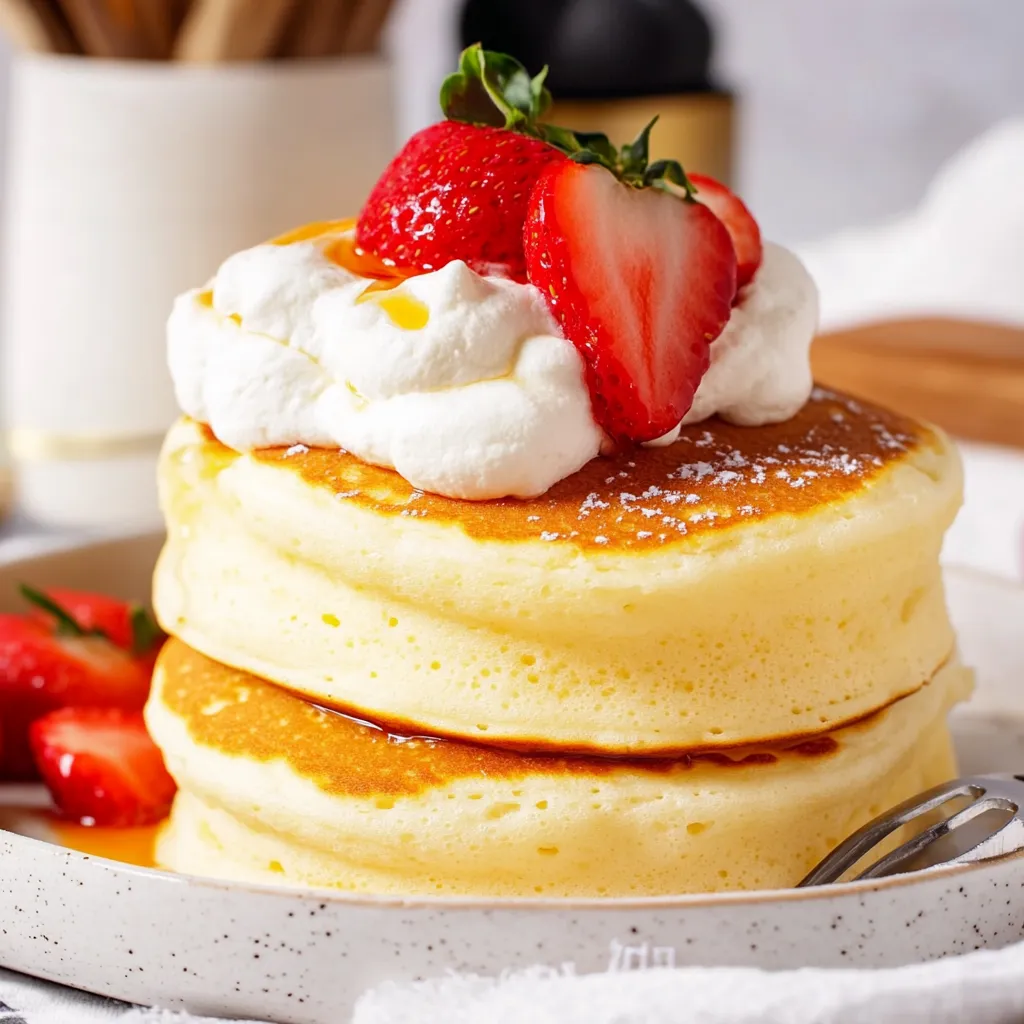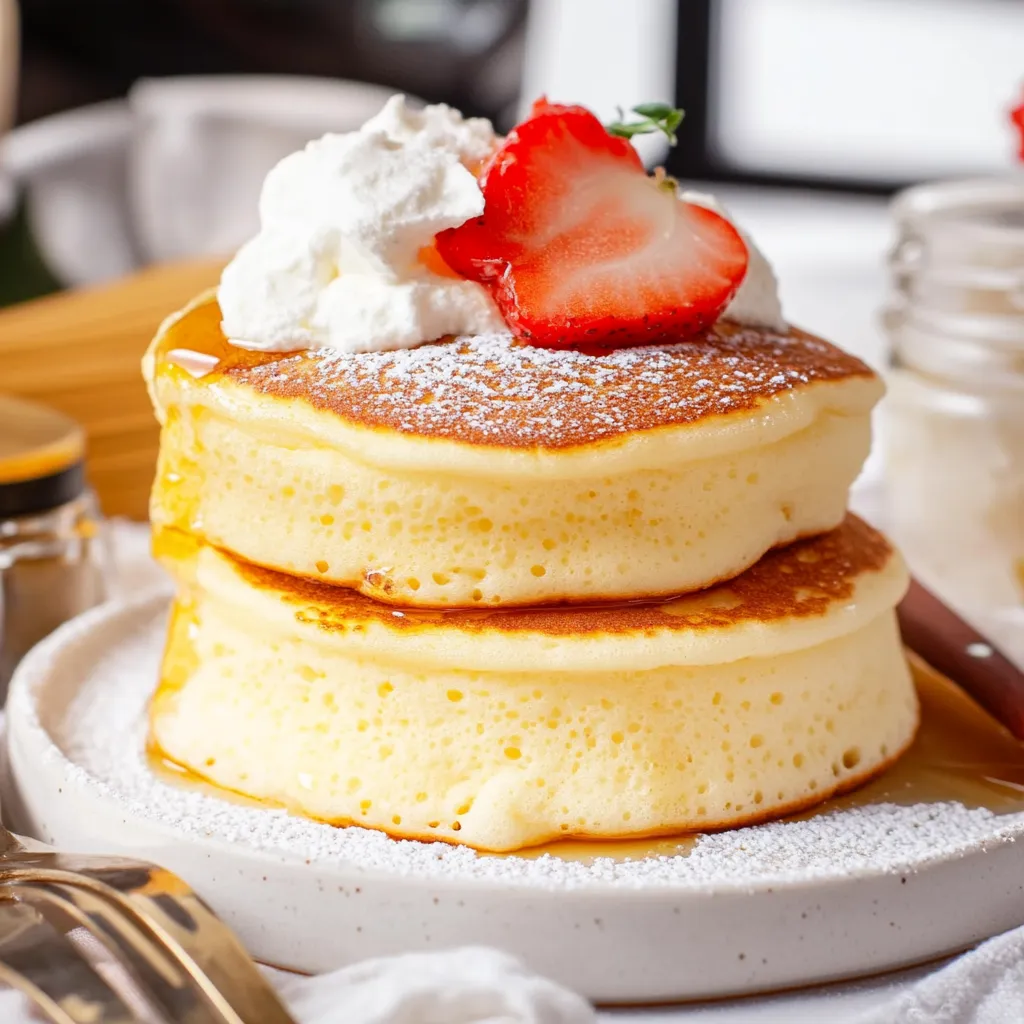 Pin it
Pin it
This pillowy Japanese soufflé pancake recipe transforms ordinary breakfast into a captivating culinary experience. Unlike traditional flat pancakes, these cloud-like creations rise tall with their signature jiggle while maintaining an incredibly tender, melt-in-your-mouth texture that has made them a sensation worldwide.
I first attempted these during a Sunday brunch experiment, and my family was mesmerized watching them cook. The delicate wobble when they hit the plate immediately turned our ordinary breakfast routine into something special that we now recreate whenever we want to make mornings memorable.
Ingredients
- Large eggs: Crucial for creating the meringue structure that gives these pancakes their signature height
- Milk: Adds necessary moisture while keeping the batter rich
- Vanilla extract: Provides warmth and classic flavor depth
- Lemon zest: Optional but adds brightness that balances the sweetness beautifully
- All-purpose flour: Provides structure while keeping texture delicate; use the spoon and level method for accurate measurement
- Baking powder: Offers extra lift beyond the meringue
- White vinegar or lemon juice: Stabilizes the egg whites for better peaks
- Granulated sugar: Sweetens and helps create the stable meringue structure
- Neutral oil: Like canola or vegetable oil prevents sticking without adding competing flavors
Step-by-Step Instructions
- Separating The Eggs:
- Carefully separate egg whites from yolks into different bowls ensuring no yolk contaminates the whites as even a tiny amount of fat will prevent proper meringue formation.
- Creating The Base Batter:
- Combine egg yolks with milk, vanilla, and lemon zest whisking gently until incorporated. Sift flour and baking powder directly into this mixture preventing lumps. Whisk until completely smooth but avoid overmixing which can develop gluten and make pancakes tough.
- Whipping The Meringue:
- Add vinegar to egg whites then begin beating with electric mixer starting at medium speed until completely frothy. Gradually incorporate sugar a small amount at a time allowing each addition to integrate fully. Increase to medium-high speed continuing until whites hold stiff peaks when the beater is lifted.
- Folding Technique:
- Add one-third of meringue to yolk mixture using a wide rubber spatula, cut down through center then sweep under and over in a gentle rolling motion. Incorporate remaining meringue in two batches using same technique until no white streaks remain but mixture still maintains volume.
- Cooking Method:
- Heat nonstick pan over consistently low heat, critical for proper rising without burning, adding just enough oil to lightly coat surface. Carefully portion batter keeping mounds tall for characteristic height. Cover immediately with lid creating mini steam chamber essential for proper rising.
- Flipping Process:
- After 7 to 8 minutes when bottom is golden and structure has set, use two spatulas to gently turn each pancake maintaining height as much as possible. Recover with lid and continue cooking at same low temperature until centers are fully set.
 Pin it
Pin it
These pancakes remind me of my first trip to a specialty pancake café in Tokyo where I watched in amazement as the chef created these delicate towers with such precision. The memory of that first bite motivated me to master this technique at home and now these pancakes have become our special Saturday morning tradition.
The Art of Meringue
Creating the perfect meringue is the cornerstone of successful soufflé pancakes. Start with room temperature egg whites which whip more effectively than cold ones. The addition of acid in the form of vinegar or lemon juice stabilizes the protein structure allowing for more air incorporation without collapsing. When beating the whites watch for visual cues rather than strictly timing. Soft peaks curve over when lifted while stiff peaks stand straight up with just the tip bending slightly. The meringue should feel smooth between your fingers not grainy indicating sugar has fully dissolved.
Troubleshooting Common Issues
If your pancakes deflate quickly you likely undermixed the meringue or overmixed when folding components together. For pancakes that brown too quickly before cooking through lower the heat further and ensure pan is completely covered during cooking. If the pancakes are too dense check that your baking powder is fresh and active. For pancakes that are too moist internally extend cooking time by a few minutes keeping heat consistently low. Remember that weather matters too as humidity can affect meringue stability so adjust accordingly on particularly humid days.
Serving Suggestions
These ethereal pancakes deserve thoughtful presentation. Serve immediately as they begin to deflate slightly as they cool. Transfer to warmed plates and top with lightly sweetened whipped cream which melts slightly into the warm pancakes. Fresh berries particularly strawberries, blueberries, or raspberries provide perfect color contrast and tartness. A light dusting of powdered sugar adds visual appeal while a small drizzle not flood of real maple syrup or honey complements without overwhelming. Consider edible flowers for special occasions or a sprinkle of matcha powder for an authentic Japanese touch.
 Pin it
Pin it
Turn your breakfast into a mouthwatering spectacle with these light, fluffy soufflé pancakes — an unforgettable treat for any occasion.
Frequently Asked Questions
- → Why did my soufflé pancakes deflate?
Soufflé pancakes can deflate if the meringue was overfolded into the batter, destroying the air bubbles that create the fluffy texture. Also, cooking at too high heat or uncovering the pan too frequently during cooking can cause deflation. For best results, fold gently and cook on low heat with minimal disturbances.
- → Can I make the batter ahead of time?
It's not recommended to make soufflé pancake batter ahead of time. The meringue will start to deflate, losing the air bubbles crucial for the fluffy texture. For best results, prepare the batter just before cooking and serve immediately.
- → What's the difference between regular pancakes and soufflé pancakes?
Regular pancakes use a simple batter with leavening agents like baking powder, while soufflé pancakes incorporate whipped egg whites (meringue) for their exceptional height and airy texture. Soufflé pancakes are also cooked more slowly at lower temperatures with a lid to help them rise properly.
- → Why do my pancakes need to be cooked covered?
Covering the pan creates a steamy environment that helps the pancakes rise evenly and cook through their centers. The trapped heat ensures the egg structure sets properly before the outside browns too quickly, resulting in tall, fluffy pancakes.
- → How do I know when my egg whites have reached stiff peaks?
Egg whites at stiff peaks will stand straight up when the beaters are lifted out of the mixture. The meringue will be glossy and hold its shape firmly. You can test by turning the bowl upside down—properly whipped egg whites won't fall out.
- → Can I use a substitute for eggs in this recipe?
Unfortunately, egg substitutes won't work well for soufflé pancakes. The unique properties of egg whites create the signature meringue that gives these pancakes their distinctive texture and height. This recipe relies on the structural properties of real eggs.
